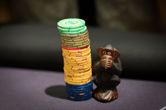Three No-Limit Hold'em Moves You Can Use

In my last column I covered some reverse tells you could use to throw your opponents off the scent. Today I'd like briefly to touch on three classic poker moves you can use in cash games to win money you might not normally win if you played your hand straightforwardly.
These will be very brief explanations of the moves, followed by links to longer discussions of each. The three moves are...
- The Squeeze Play
- Set Mining
- The Float Play
The Squeeze Play
The squeeze play is a little like a combination shot in pool. It involves two opponents, not just one. For you to use it you need one player, preferably a loose-aggressive opponent, to raise and then another player to call that raise. When that happens, and you have a relatively tight image, you can often win the pot right away by putting in your own raise — a significant one — as a "squeeze."
In this situation you raise because you want both opponents to fold assuming you must be very strong to make your move. To understand this best, first put yourself into the mind of your loose-aggressive raiser. He sees your raise and says to himself, "Wow, that guy must be very strong. He's not just raising me — someone he knows might raise without a strong hand — but he's raising another player, too, who has already called. I guess I'll fold this one and live to fight another day."
Meanwhile the guy who called is probably thinking, "I called the loose-aggressive guy because he raises with nothing. But the guy who raised me is fairly tight. He must be really strong to raise us both. I'll fold and live to pick off the loose-aggressive guy another time when no one else has a really strong hand."
In essence, the squeeze play is a bluff with extra believability because it is made against two opponents.
For further discussion about the conditions for making the squeeze play and bet sizing when trying the move, see "10 Hold'em Tips: Making the Squeeze Play."
Set Mining
This is a very simple action done preflop when you hold a small- or medium-sized pair.
An opponent raises. You have a low or medium pair. You call with the hope of hitting a set on the flop. You don't do this blindly or automatically. You expect to hit your set only around once every eight times. That means for the move to show a profit, you will need to extract at least eight times the cost of your call — preferably more.
For this to happen, you and your opponent need to have stacks that are at least eight times as large as the bet you call. You also need to be fairly certain your opponent will call your bet if you do hit a set.
Counterintuitively (and unlike what some others have written about this move), this means that non-expert, tight players ideal opponents for set mining. Players who play few hands tend to be less likely to release their hands when you hit your set and they have bet aggressively preflop.
Unlike a loose-aggressive opponent who will often bet with a hand of little value, then release it when he senses strength elsewhere, the tight player tends not to be aggressive preflop without a high quality hand. Unless the board is obviously scary, he'll continue to bet aggressively with one of those few hands in his preflop raising range (including premium pairs).
If you start with a low pair and hit a set, then, such an opponent will generally continue to push the betting on the flop and turn, allowing you to build the pot passively to such a point that he may not be able to find a fold on the river when you show aggression.
For more particulars regarding how and when to try set mining as well as postflop strategy for getting paid off, see "10 Hold'em Tips: Fundamentals of Set Mining."
The Float Play
A float play is a type of bluff, usually involving action on both the flop and the turn. A player applying this play would call a leading bet from late position, typically on the flop, with the expectation of betting if an early-position opponent checks on the following street.
This play is done to take advantage of opponents who frequently make continuation bets on the flop. Your call is done because you expect that they do not really have a hand. When your opponent then checks on the turn, you make a fairly large bet — say, two-thirds to three-fourths of the pot — to pressure your opponent to fold.
The float play can be done with any two cards, as you are relying entirely on your opponent's expected fold to win the hand. It's also important to realize the play works best if you have a tight image, and if you know your opponent has a proclivity to make continuation bet.
Be warned, though, the play should be used sparingly, as your good opponents may recognize what you are doing and take counter-measures like check-raising you on the turn when they have a decent hand.
For more on the float play including an example and some discussion about board texture and other factors affecting the play's success, see "10 More Hold'em Tips: The Float Play."
Ashley Adams has been playing poker for 50 years and writing about it since 2000. He is the author of hundreds of articles and two books, Winning 7-Card Stud (Kensington 2003) and Winning No-Limit Hold'em (Lighthouse 2012). He is also the host of poker radio show House of Cards. See www.houseofcardsradio.com for broadcast times, stations, and podcasts.










